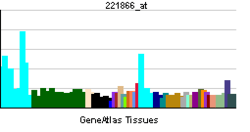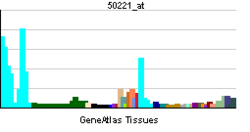TFEB
| View/Edit Human | View/Edit Mouse |
Transcription factor EB is a protein that in humans is encoded by the TFEB gene.[3][4]
Function
TFEB is a master gene for lysosomal biogenesis.[5] It encodes a transcription factor that coordinates expression of lysosomal hydrolases, membrane proteins and genes involved in autophagy.[5] Under aberrant lysosomal storage conditions such as in lysosomal storage diseases, TFEB translocated from the cytoplasm to the nucleus, resulting in the activation of its target genes.[5] TFEB overexpression in cultured cells induced lysosomal biogenesis and increased the degradation of complex molecules, such as glycosaminoglycans and the pathogenic protein that causes Huntington disease.[5] TFEB is activated by PGC1-alpha and promotes reduction of htt aggregation and neurotoxicity in a mouse model of Huntington disease.[6]
Nuclear localization and activity of TFEB is inhibited by serine phosphorylation by mTORC1 and extracellular signal–regulated kinase 2 (ERK2). mTORC1 phosphorylation of TFEB occurs at the lysosomal surface, both of which are localized there by interaction with the Rag GTPases. Phosphorylated TFEB is then retained in the cytosol by interaction with 14-3-3 proteins.[7][8][9] These kinases are tuned to the levels of extracellular nutrients suggesting a coordination in regulation of autophagy and lysomal biogenesis and partnership of two distinct cellular organelles.[10] TFEB is activated in Trex1-deficient cells via inhibition of mTORC1 activity, resulting in an expanded lysosomal compartment.[11]
References
- ↑ "Human PubMed Reference:".
- ↑ "Mouse PubMed Reference:".
- ↑ Carr CS, Sharp PA (Aug 1990). "A helix-loop-helix protein related to the immunoglobulin E box-binding proteins". Molecular and Cellular Biology. 10 (8): 4384–8. doi:10.1128/mcb.10.8.4384. PMC 360994
 . PMID 2115126.
. PMID 2115126. - ↑ "Entrez Gene: TFEB transcription factor EB".
- 1 2 3 4 Sardiello M, Palmieri M, di Ronza A, Medina DL, Valenza M, Gennarino VA, Di Malta C, Donaudy F, Embrione V, Polishchuk RS, Banfi S, Parenti G, Cattaneo E, Ballabio A (Jul 2009). "A gene network regulating lysosomal biogenesis and function". Science. 325 (5939): 473–7. doi:10.1126/science.1174447. PMID 19556463.
- ↑ Tsunemi T, Ashe TD, Morrison BE, Soriano KR, Au J, Roque RA, Lazarowski ER, Damian VA, Masliah E, La Spada AR (Jul 2012). "PGC-1α rescues Huntington's disease proteotoxicity by preventing oxidative stress and promoting TFEB function". Science Translational Medicine. 4 (142): 142ra97. doi:10.1126/scitranslmed.3003799. PMID 22786682.
- ↑ Martina JA, Chen Y, Gucek M, Puertollano R (Jun 2012). "MTORC1 functions as a transcriptional regulator of autophagy by preventing nuclear transport of TFEB". Autophagy. 8 (6): 903–14. doi:10.4161/auto.19653. PMC 3427256
 . PMID 22576015.
. PMID 22576015. - ↑ Martina JA, Puertollano R (Jun 2013). "RRAG GTPases link nutrient availability to gene expression, autophagy and lysosomal biogenesis". Autophagy. 9 (6): 928–30. doi:10.4161/auto.24371. PMC 3672304
 . PMID 23524842.
. PMID 23524842. - ↑ Roczniak-Ferguson A, Petit CS, Froehlich F, Qian S, Ky J, Angarola B, Walther TC, Ferguson SM (Jun 2012). "The transcription factor TFEB links mTORC1 signaling to transcriptional control of lysosome homeostasis". Science Signaling. 5 (228): ra42. doi:10.1126/scisignal.2002790. PMC 3437338
 . PMID 22692423.
. PMID 22692423. - ↑ Settembre C, Di Malta C, Polito VA, Garcia Arencibia M, Vetrini F, Erdin S, Erdin SU, Huynh T, Medina D, Colella P, Sardiello M, Rubinsztein DC, Ballabio A (Jun 2011). "TFEB links autophagy to lysosomal biogenesis". Science. 332 (6036): 1429–33. doi:10.1126/science.1204592. PMID 21617040.
- ↑ Hasan M, Koch J, Rakheja D, Pattnaik AK, Brugarolas J, Dozmorov I, Levine B, Wakeland EK, Lee-Kirsch MA, Yan N (Jan 2013). "Trex1 regulates lysosomal biogenesis and interferon-independent activation of antiviral genes". Nature Immunology. 14 (1): 61–71. doi:10.1038/ni.2475. PMID 23160154.
Further reading
- Steingrímsson E, Sawadogo M, Gilbert DJ, Zervos AS, Brent R, Blanar MA, Fisher DE, Copeland NG, Jenkins NA (Jul 1995). "Murine chromosomal location of five bHLH-Zip transcription factor genes". Genomics. 28 (2): 179–83. doi:10.1006/geno.1995.1129. PMID 8530024.
- Steingrímsson E, Tessarollo L, Reid SW, Jenkins NA, Copeland NG (Dec 1998). "The bHLH-Zip transcription factor Tfeb is essential for placental vascularization". Development. 125 (23): 4607–16. PMID 9806910.
- Verastegui C, Bertolotto C, Bille K, Abbe P, Ortonne JP, Ballotti R (Mar 2000). "TFE3, a transcription factor homologous to microphthalmia, is a potential transcriptional activator of tyrosinase and TyrpI genes". Molecular Endocrinology. 14 (3): 449–56. doi:10.1210/me.14.3.449. PMID 10707962.
- Davis IJ, Hsi BL, Arroyo JD, Vargas SO, Yeh YA, Motyckova G, Valencia P, Perez-Atayde AR, Argani P, Ladanyi M, Fletcher JA, Fisher DE (May 2003). "Cloning of an Alpha-TFEB fusion in renal tumors harboring the t(6;11)(p21;q13) chromosome translocation". Proceedings of the National Academy of Sciences of the United States of America. 100 (10): 6051–6. doi:10.1073/pnas.0931430100. PMC 156324
 . PMID 12719541.
. PMID 12719541. - Kuiper RP, Schepens M, Thijssen J, van Asseldonk M, van den Berg E, Bridge J, Schuuring E, Schoenmakers EF, van Kessel AG (Jul 2003). "Upregulation of the transcription factor TFEB in t(6;11)(p21;q13)-positive renal cell carcinomas due to promoter substitution". Human Molecular Genetics. 12 (14): 1661–9. doi:10.1093/hmg/ddg178. PMID 12837690.
- Kuiper RP, Schepens M, Thijssen J, Schoenmakers EF, van Kessel AG (2004). "Regulation of the MiTF/TFE bHLH-LZ transcription factors through restricted spatial expression and alternative splicing of functional domains". Nucleic Acids Research. 32 (8): 2315–22. doi:10.1093/nar/gkh571. PMC 419459
 . PMID 15118077.
. PMID 15118077. - Argani P, Laé M, Hutchinson B, Reuter VE, Collins MH, Perentesis J, Tomaszewski JE, Brooks JS, Acs G, Bridge JA, Vargas SO, Davis IJ, Fisher DE, Ladanyi M (Feb 2005). "Renal carcinomas with the t(6;11)(p21;q12): clinicopathologic features and demonstration of the specific alpha-TFEB gene fusion by immunohistochemistry, RT-PCR, and DNA PCR". The American Journal of Surgical Pathology. 29 (2): 230–40. doi:10.1097/01.pas.0000146007.54092.37. PMID 15644781.
- Rual JF, Venkatesan K, Hao T, Hirozane-Kishikawa T, Dricot A, Li N, Berriz GF, Gibbons FD, Dreze M, Ayivi-Guedehoussou N, Klitgord N, Simon C, Boxem M, Milstein S, Rosenberg J, Goldberg DS, Zhang LV, Wong SL, Franklin G, Li S, Albala JS, Lim J, Fraughton C, Llamosas E, Cevik S, Bex C, Lamesch P, Sikorski RS, Vandenhaute J, Zoghbi HY, Smolyar A, Bosak S, Sequerra R, Doucette-Stamm L, Cusick ME, Hill DE, Roth FP, Vidal M (Oct 2005). "Towards a proteome-scale map of the human protein-protein interaction network". Nature. 437 (7062): 1173–8. doi:10.1038/nature04209. PMID 16189514.
- Pecciarini L, Cangi MG, Lo Cunsolo C, Macri' E, Dal Cin E, Martignoni G, Doglioni C (May 2007). "Characterization of t(6;11)(p21;q12) in a renal-cell carcinoma of an adult patient". Genes, Chromosomes & Cancer. 46 (5): 419–26. doi:10.1002/gcc.20422. PMID 17285572.

